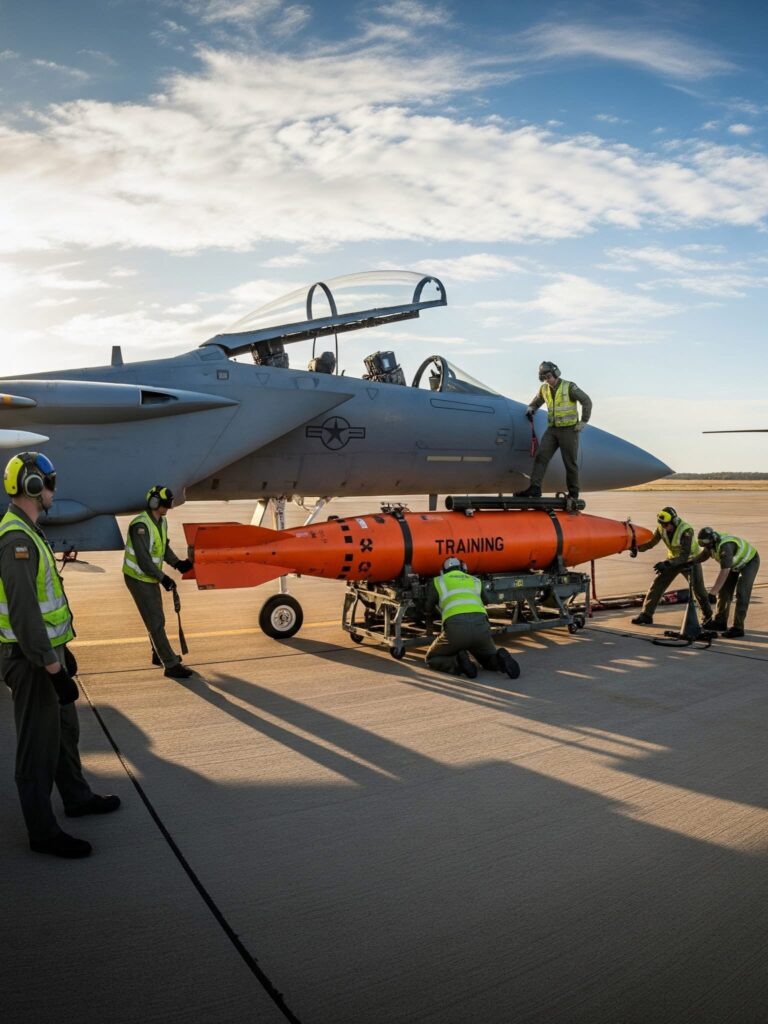
The process of loading a nuclear bomb onto an F-15 Eagle fighter jet is not only a technical task but also a highly controlled and secure operation. The F-15, a twin-engine, all-weather tactical fighter, has been a cornerstone of U.S. air superiority since the 1970s. While its most common missions involve conventional weaponry, it has also been configured under specific circumstances to carry nuclear ordnance as part of America’s strategic deterrence posture. Every step of this process emphasizes precision, safety, and strict adherence to protocols.
Before any nuclear weapon is loaded, the airbase enters an elevated security status. Armed guards patrol the perimeter, and only personnel with the highest levels of security clearance are allowed near the jet or the weapon storage area. The bomb itself is typically stored in a secure underground Weapons Storage and Security System (WS3) vault, located inside hardened aircraft shelters. When the order is given, the vault is opened using multi-step authentication involving multiple officers to prevent unauthorized access.
Transporting the nuclear bomb from storage to the aircraft is itself a sensitive operation. A specialized weapons trailer, often heavily armored, is used to move the bomb under escort. During the transfer, communications are tightly monitored, and security teams surround the convoy. Any deviation from the approved procedure would immediately trigger alerts and potential lockdowns.
At the flight line, the F-15 Eagle is prepared for loading. The aircraft undergoes a full inspection to ensure all systems are functioning correctly. Ground crews verify the weapon pylons and racks are properly configured to receive the bomb. In the case of nuclear weapons, the jet typically uses a specially modified pylon designed to secure the bomb firmly and ensure proper integration with the aircraft’s electronics.
Loading the bomb requires both human expertise and advanced equipment. A mechanical loader carefully lifts the weapon into position under the aircraft’s fuselage or wing station. Crew members guide the process, ensuring no damage occurs to the sensitive weapon casing. Once aligned, the bomb is locked into place, and technicians connect its electronic interface with the F-15’s fire control and release systems. Double and triple checks are performed at each stage, with multiple personnel verifying the status before proceeding.
The final stage involves systems integration checks. The cockpit displays are activated, and the pilot, along with ground technicians, ensures that the bomb’s arming and release mechanisms communicate correctly with the aircraft’s avionics. It is important to note that nuclear bombs are designed with multiple safeguards to prevent accidental detonation. They cannot be armed without a coded input, known as a Permissive Action Link (PAL), which requires top-level authorization from national command authority.
Once the weapon is loaded and all systems verified, the aircraft is placed on standby. Whether the mission is training or an actual alert, the F-15 now becomes part of the nuclear strike readiness force. Throughout the Cold War, this kind of readiness was a key part of deterrence strategy, ensuring adversaries knew the U.S. could deliver a decisive response if necessary.
In conclusion, loading a nuclear bomb onto an F-15 Eagle is a carefully choreographed process involving security, technical precision, and strict command oversight. It highlights not only the destructive power of modern air warfare but also the extraordinary responsibility placed on those who handle and operate such weapons.


